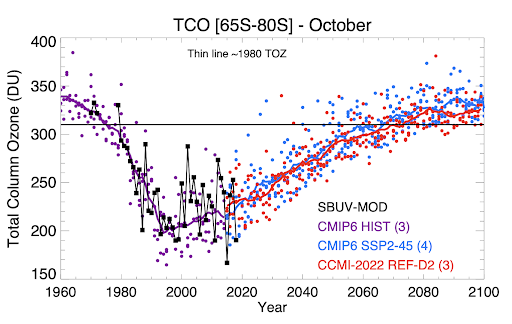Modeling Intercomparison Projects
The World Meteorological Organization (WMO) Global Ozone Research and Monitoring project is tasked every four years with assessing the scientific understanding of the stratospheric ozone layer. This assessment contains information upon which the “Parties to the Montreal Protocol on Substances that Deplete the Ozone Layer will base their future decisions regarding the protection of the stratospheric ozone layer and climate from the production and consumption of ozone-depleting substances (ODSs) and their replacements” (WMO, 2018). For the current ongoing WMO (2022) assessment, scientists at NCAR ACOM have been nominated to participate in two chapters: “Update on Polar Ozone: Past, Present, and Future” (Douglas Kinnison, co-author Chapter 4); and a completely new chapter on “Stratospheric aerosol injection and its potential effects on the stratospheric ozone layer” (Simone Tilmes, lead author, Chapter 6).
The WMO (2022) uses new ozone projections from state-of-the-art chemistry-climate models (CCMs), which include results from the CESM2 Whole Atmosphere Community Climate Model version 6 (WACCM6). CESM2 (WACCM6) has a horizontal resolution of ~1 degree and a vertical extend from the surface to the lower thermosphere (~140km) and has a detailed representation of tropospheric and stratospheric chemical processes (~240 species and >450 chemical reactions). Figure 1 shows results from CESM2(WACCM6) based on scenarios defined by the Coupled Model Intercomparison Project (CMIP6) (Meinhausen et al., 2017, 2020) and the Chemistry Climate Model Initiative (CCMI-2022) (Plummer et al. 2020). All the model configurations shown in this figure have an interactive QBO and interactive ocean. This figure depicts the Antarctic October mean evolution of total column ozone (TCO) for both the hindcast period (1960-2014) and the forecast period (2015-2100). The observations (Frith et al., 2017) and the WACCM6 results show a large ozone depletion starting in ~1960 and maximizing in the late 1990s. This is consistent with the evolution of the ozone depleting substances (ODSs), which peaked in the late 1990s and recovered to 1980 abundance later in the 21st century. The model suggests the TCO recovery to 1980 conditions is near the year 2060. The REF-D2 shows a slight delay in this recovery relative to the SSP2-45. This is due to the updated halogen recovery scenario assumed in the REF-D2, which has an ODS delay of ~5 years relative to the SSP2-45 scenario. Additional model simulations have been created to assess the effects of stratospheric aerosol injections (SAI) on the ozone layer that will be investigated in the CCMI multi-model context. The participation of CESM2 (WACCM6) in multi-model comparisons is important for assessments and model improvements (e.g., Keeble et al., 2021).

References:
Frith, S.M., R.S. Stolarski, N.A. Kramarova, and R.D. McPeters, Estimating uncertainties in the SBUV Version 8.6 merged profile ozone data set, Atmos. Chem. Phys., 17, 14695–14707, doi:10.5194/acp-17-14695-2017, 2017
Keeble, J., Hassler, B., Banerjee, A., Checa-Garcia, R., Chiodo, G., Davis, S., Eyring, V., Griffiths, P. T., Morgenstern, O., Nowack, P., Zeng, G., Zhang, J., Bodeker, G., Burrows, S., Cameron-Smith, P., Cugnet, D., Danek, C., Deushi, M., Horowitz, L. W., Kubin, A., Li, L., Lohmann, G., Michou, M., Mills, M. J., Nabat, P., Olivié, D., Park, S., Seland, Ø., Stoll, J., Wieners, K.-H., and Wu, T.: Evaluating stratospheric ozone and water vapour changes in CMIP6 models from 1850 to 2100, Atmos. Chem. Phys., 21, 5015–5061, https://doi.org/10.5194/acp-21-5015-2021, 2021.
Meinshausen, M., E. Vogel, A. Nauels, K. Lorbacher, N. Meinshausen, D.M. Etheridge, P.J. Fraser, S.A. Montzka, P.J. Rayner, C.M. Trudinger, P.B. Krummel, U. Beyerle, J.G. Canadell, J.S. Daniel, I.G. Enting, R.M. Law, C.R. Lunder, S. O’Doherty, R.G. Prinn, S. Reimann, M. Rubino, G.J.M. Velders, M.K. Vollmer, R.H.J. Wang, and R. Weiss, Historical greenhouse gas concentrations for climate modelling (CMIP6), Geosci. Model Dev., 10, 2057–2116, doi:10.5194/gmd-10-2057-2017, 2017.
Meinshausen, M., Z.R.J. Nicholls, J. Lewis, M.J. Gidden, E. Vogel, M. Freund, U. Beyerle, C. Gessner, A. Nauels, N. Bauer, J.G. Canadell, J.S. Daniel, A. John, P.B. Krummel, G. Luderer, N. Meinshausen, S.A. Montzka, P.J. Rayner, S. Reimann, S.J. Smith, M. van den Berg, G.J.M. Velders, M.K. Vollmer, and R.H.J. Wang, The shared socioeconomic pathway (SSP) greenhouse gas concentrations and their extensions to 2500, Geosci. Model Dev., 13, 3571–3605, doi:10.5194/gmd-13-3571-2020, 2020.
Plummer et al., CCMI-2022: A new set of Chemistry-Climate Model Initiative (CCMI) Community Simulations to Update the Assessment of Models and Support Upcoming Ozone Assessment Activities, SPARC newsletter n°57 – July 2021.
WMO (World Meteorological Organization), Scientific Assessment of Ozone Depletion: 2018, Global Ozone Research and Monitoring Project – Report No. 58, 588 pp., Geneva, Switzerland, 2018.